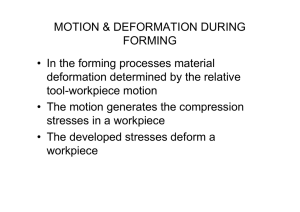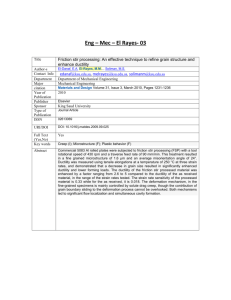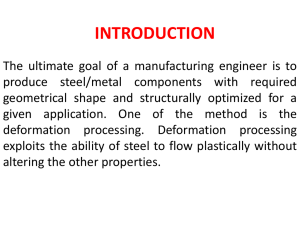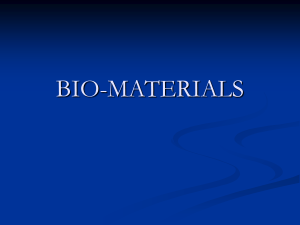ch15 - lecture
advertisement
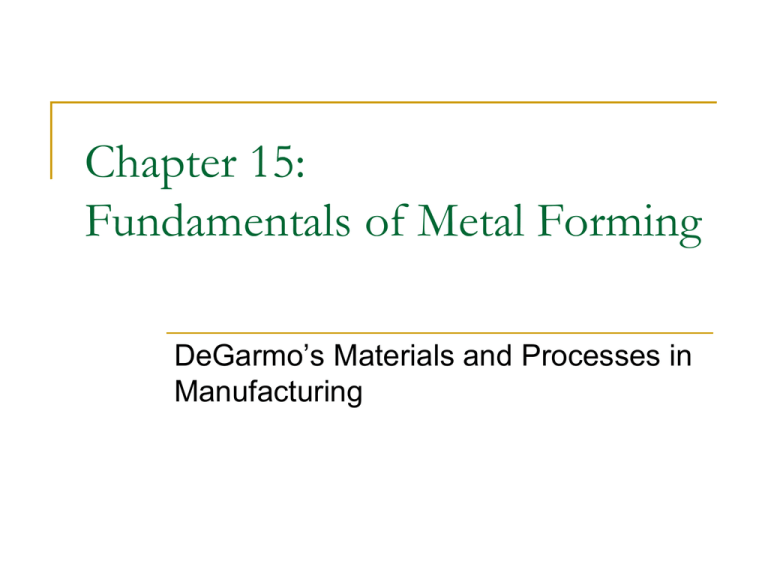
Chapter 15: Fundamentals of Metal Forming DeGarmo’s Materials and Processes in Manufacturing 15.1 Introduction Deformation processes have been designed to exploit the plasticity of engineering materials Plasticity is the ability of a material to flow as a solid without deterioration of properties Deformation processes require a large amount of force Processes include bulk flow, simple shearing, or compound bending States of Stress 15.2 Forming Processes: Independent Variables Forming processes consist of independent and dependent variables Independent variables are the aspects of the processes that the engineer or operator has direct control Starting material Starting geometry of the workpiece Tool or die geometry Lubrication Starting temperature Speed of operation Amount of deformation Forming Operations Forming Operations Forming Operations 15.3 Dependent Variables Dependent variables are those that are determined by the independent variable selection Force or power requirements Material properties of the product Exit or final temperature Surface finish and precision Nature of the material flow 15.4 Independent-Dependent Relationships Independent variables- control is direct and immediate Dependent variables- control is entirely indirect Determined by the process If a dependent variable needs to be controlled, the designer must select the proper independent variable that changes the dependent variable Independent-Dependent Relationships Information on the interdependence of independent and dependent variables can be learned in three ways Experience Experiment Process modeling Figure 15-1 Schematic representation of a metalforming system showing independent variables, dependent variables, and the various means of linking the two. 15.5 Process Modeling Simulations are created using finite element modeling Models can predict how a material will respond to a rolling process, fill a forging die, flow through an extrusion die, or solidify in a casting Heat treatments can be simulation Costly trial and error development cycles can be eliminated 15.6 General Parameters Material being deformed must be characterized Strength or resistance for deformation Conditions at different temperatures Formability limits Reaction to lubricants Speed of deformation and its effects Speed-sensitive materials- more energy is required to produce the same results 15.7 Friction and Lubrication Under Metalworking Conditions High forces and pressures are required to deform a material For some processes, 50% of the energy is spent in overcoming friction Changes in lubrication can alter material flow, create or eliminate defects, alter surface finish and dimensional precision, and modify product properties Production rates, tool design, tool wear, and process optimization depend on the ability to determine and control friction Friction Conditions Metalforming friction differs from the friction encountered in mechanical devices For light, elastic loads, friction is proportional to the applied pressure μ is the coefficient of friction At high pressures, friction is related to the strength of the weaker material Figure 15-2 The effect of contact pressure on the frictional resistance between two surfaces. Friction Friction is resistance to sliding along an interface Resistance can be attributed to: Abrasion Adhesion Resistance is proportional to the strength of the weaker material and the contact area Surface Deterioration Surface wear is related to friction Wear on the workpiece is not objectionable, but wear on the tooling is Tooling wear is economically costly and can impact dimensional precision Tolerance control can be lost Tool wear can impact the surface finish Lubrication Key to success in many metalforming operations Primarily selected to reduce friction and tool wear, but may be used as a thermal barrier, coolant, or corrosion retardant Other factors Ease of removal, lack of toxicity, odor, flammability, reactivity, temperature, velocity, wetting characteristics 15.8 Temperature Concerns Workpiece temperature can be one of the most important process variables In general, an increase in temperature is related to a decrease in strength, increase in ductility, and decrease in the rate of strain hardening Hot working Cold working Warm working Hot Working Plastic deformation of metals at a temperature above the recrystallization temperature Temperature varies greatly with material Recrystallization removes the effects of strain hardening Hot working may produce undesirable reactions from the metal and its surroundings Structure and Property Modification by Hot Working The size of grains upon cooling is not typically uniform Undesirable grain shapes can be common (such as columnar grains) Recrystallization is followed by: grain growth additional deformation and recrystallization drop in temperature that will terminate diffusion and freeze the recrystallized structure Hot Working Engineering properties can be improved through reorienting inclusion or impurities During plastic deformation, impurities tend to flow along with the base metal or fraction into rows of fragments Figure 15-3 Cross section of a 4-in.diameter case copper bar polished and etched to show the as-cast grain structure. Figure 15-4 Etched surface of a sectioned crankshaft showing the grain flow pattern that gives forged parts enhanced strength, fracture resistance, and fatigue life. (Courtesy of the Forging Industry Association, Cleveland, OH) Temperature Variations in Hot Working Success or failure of a hot deformation process often depends on the ability to control temperatures Over 90% of the energy imparted to a deforming workpiece is converted to heat Nonuniform temperatures may be produced and may result in cracking Thin sections cool faster than thick sections Figure 15-5 Schematic comparison of the grain flow in a machined thread (a) and a rolled thread (b). The rolling operation further deforms the axial structure produced by the previous wire- or rod-forming operations, while machining simply cuts through it. Cold Working Plastic deformation below the recrystallization temperature Advantages as compared to hot working No heating required Better surface finish Superior dimensional control Better reproducibility Strength, fatigue, and wear are improved Directional properties can be imparted Contamination is minimized Disadvantages of Cold Working Higher forces are required to initiate and complete the deformation Heavier and more powerful equipment and stronger tooling are required Less ductility is available Metal surfaces must be clean and scale-free Intermediate anneals may be required Imparted directional properties can be detrimental Undesirable residual stresses may be produced Metal Properties and Cold Working Two features that are significant in selecting a material for cold working are Magnitude of the yield-point stress Extent of the strain region from yield stress to fracture Springback should also be considered when selecting a material Figure 15-6 Use of true stress-true strain diagram to assess the suitability of two metals for cold working. Initial and Final Properties in a ColdWorking Process Quality of the starting material is important to the success or failure of the cold-working process The starting material should be clean and free of oxide or scale that might cause abrasion to the dies or rolls Figure 15-7 (Below) Stress-strain curve for a low-carbon steel showing the commonly observed yield-point runout; (Right) Luders bands or stretcher strains that form when this material is stretched to an amount less than the yield-point runout. Additional Effects of Cold Working Annealing heat treatments may be performed prior or at intermediate intervals to cold working Heat treatments allows additional cold working and deformation processes Cold working produces a structure where properties vary with direction, anisotropy Figure 15-8 Mechanical properties of pure copper as a function of the amount of cold work (expressed in percent). Warm Forming Deformations produced at temperatures intermediate to cold and hot working Advantages Reduced loads on the tooling and equipment Increased material ductility Possible reduction in the number of anneals Less scaling and decarburization Better dimensional precision and smoother surfaces than hot working Used for processes such as forging and extrusion Warm Forming Figure 15-9 Increasing the temperature increases the formability of aluminum, decreasing the strength and increasing the ductility. (Adapted from data provided by Interlaken Technology Corporation, Chaska, MN) Isothermal Forming Deformation that occurs under constant temperature Dies and tooling are heated to the same temperature as the workpiece Eliminates cracking from nonuniform surface temperatures Inert atmospheres may be used Figure 15-10 Yield strength of various materials (as indicated by pressure required to forge a standard specimen) as a function of temperature. Materials with steep curves may require isothermal forming. (From “A Study of Forging Variables,” ML-TDR-6495, March 1964; courtesy of Battelle Columbus Laboratories, Columbus, OH.)
